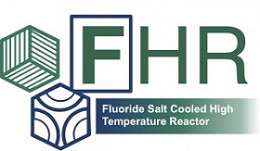UC Berkeley’s recent project to develop a new pre-conceptual design for a Mark 1 Pebble-Bed FHR (Mk1 PB-FHR) had four major goals:
- Demonstrate a plausible, self-consistent Nuclear Air Combined Cycle (NACC) system design
– Believable predictions for base-load and peaking power levels using an industry-standard design code (Thermoflex)
2 archival articles describing NACC now published in the ASME Journal of Engineering for Gas Turbines and Power [28], [29]
– Self-consistent approach to heat air directly with primary coolant using a Coiled Tube Air Heater (CTAH)
- Provide a sufficiently detailed design for FHR decay heat management systems to enable future studies of FHR safety
– Provide basis for establishing experiment test matrix for integral effects testing in the UCB Compact Integral Effects Test (CIET) facility
– Provide a reference system design to use future in FHR thermal hydraulics code validation and benchmarking exercises
- Develop a credible annular FHR pebble core design to enable safety studies and FHR code benchmarking
– Inner and outer graphite reflector
– Pebble injection and defueling
– Coolant flow distribution and pressure loss
– Neutronics/depletion/control-rod worth calculations
- Identify additional systems and develop a notional FHR reactor building arrangement
– “Black-box” level of design for many of these systems
– Include beryllium and tritium management strategies
– Provide a reference for performing future FHR life cycle assessment (LCA) studies

